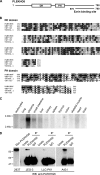Interaction of ezrin with the novel guanine nucleotide exchange factor PLEKHG6 promotes RhoG-dependent apical cytoskeleton rearrangements in epithelial cells
- PMID: 17881735
- PMCID: PMC2096603
- DOI: 10.1091/mbc.e06-12-1144
Interaction of ezrin with the novel guanine nucleotide exchange factor PLEKHG6 promotes RhoG-dependent apical cytoskeleton rearrangements in epithelial cells
Abstract
The mechanisms underlying functional interactions between ERM (ezrin, radixin, moesin) proteins and Rho GTPases are not well understood. Here we characterized the interaction between ezrin and a novel Rho guanine nucleotide exchange factor, PLEKHG6. We show that ezrin recruits PLEKHG6 to the apical pole of epithelial cells where PLEKHG6 induces the formation of microvilli and membrane ruffles. These morphological changes are inhibited by dominant negative forms of RhoG. Indeed, we found that PLEKHG6 activates RhoG and to a much lesser extent Rac1. In addition we show that ezrin forms a complex with PLEKHG6 and RhoG. Furthermore, we detected a ternary complex between ezrin, PLEKHG6, and the RhoG effector ELMO. We demonstrate that PLEKHG6 and ezrin are both required in macropinocytosis. After down-regulation of either PLEKHG6 or ezrin expression, we observed an inhibition of dextran uptake in EGF-stimulated A431 cells. Altogether, our data indicate that ezrin allows the local activation of RhoG at the apical pole of epithelial cells by recruiting upstream and downstream regulators of RhoG and that both PLEKHG6 and ezrin are required for efficient macropinocytosis.
Figures








References
-
- Aghazadeh B., Zhu K., Kubiseski T. J., Liu G. A., Pawson T., Zheng Y., Rosen M. K. Structure and mutagenesis of the Dbl homology domain. Nat. Struct. Biol. 1998;5:1098–1107. - PubMed
-
- Berryman M., Franck Z., Bretscher A. Ezrin is concentrated in the apical microvilli of a wide variety of epithelial cells whereas moesin is found primarily in endothelial cells. J. Cell Sci. 1993;105:1025–1043. - PubMed
-
- Blangy A., Vignal E., Schmidt S., Debant A., Gauthier-Rouviere C., Fort P. TrioGEF1 controls Rac- and Cdc42-dependent cell structures through the direct activation of rhoG. J. Cell Sci. 2000;113(Pt 4):729–739. - PubMed
Publication types
MeSH terms
Substances
LinkOut - more resources
Full Text Sources
Molecular Biology Databases
Research Materials

